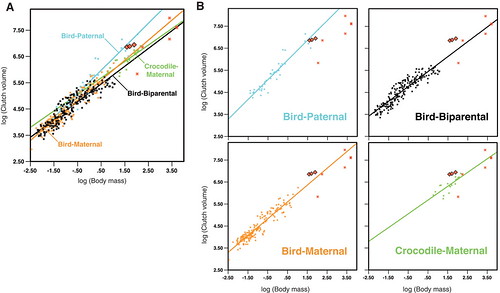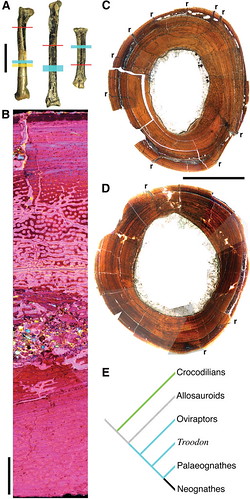tags: evolution, behavioral ecology, parental care, egg incubation, dinosaurs, birds
The Oviraptorid dinosaur, Citipati osmolskae,
on a nest of eggs that was unearthed in the Gobi desert
of Mongolia by the American Museum of Natural History.
Image: Mick Ellison, American Museum of Natural History.
Oviraptors ("egg seizer") were given their name because their fossil remains were first discovered on top of a pile of eggs. Because of their close proximity to clutches of dinosaur eggs, it was initially assumed that these dinosaurs were eating them. However, in his 1924 paper, their discoverer Henry Fairfield Osborn cautioned the scientific community by writing that the name Oviraptor "may entirely mislead us as to its feeding habits and belie its character."
Indeed.
Newly published research suggests that these dinosaurs were likely incubating these eggs, rather than eating them. Further, because of the size of both the eggs and the clutch, it is likely that it was actually the father who was caring for the eggs and chicks, instead of the mother.
"The basic argument is that if the mother is taking care of the eggs then she doesn't have as much time to go out and feed and gain energy for herself, so she can't invest as much in her eggs," said one of the paper's authors, Jason Moore, of Texas A&M University. "She can't make her eggs very big, or she can't make loads of eggs because she can't get enough energy to build those eggs."
Nearly all of the living dinosaurs (the birds), share parental duties between males and females. But interestingly, among the ratites and tinamous (the Paleognaths, which are basal in the avian lineage), the male is solely responsible for providing parental care. However, among crocodiles, the closest living relatives to birds, maternal care predominates. In view of these data, which is the ancestral condition? Is female parental care specific to the crocodilians, or is male parental care specific to the paleognaths? Which form of parental care was ancestral among birds?
David Varricchio of Montana State University and several colleagues from around the country collaborated to answer these questions. They chose to examine dinosaurs that were closely related to birds and shared several characters with them, including asymmetrically-shaped eggs with hard multilayered shells, and production of single eggs on a daily or greater time scale. Additionally, adult Troodon formosus and two oviraptorids, Oviraptor philoceratops and Citipati osmolskae, discovered on top of egg clutches often had postures with an uncanny resemblance to those of incubating birds.
The researchers first compared total clutch volumes to adult body mass for 433 living archosaurs that exhibit different parental care systems: crocodilian-maternal, and birds with three different types of parental care; bird-biparental, bird-maternal and bird-paternal care (Fig. 1);
Fig. 1. Clutch volume versus adult body mass for extant archosaurs, divided into four taxon/care models (7). Species data points and corresponding regression lines are plotted together (A) or separately by model (B). Color code for all graphs: green, crocodile-maternal; black, bird-biparental; orange, bird-maternal; blue, bird-paternal; red diamonds, non-avian maniraptoran dinosaurs (Troodon, Oviraptor, and Citipati); red stars, other non-avian dinosaurs. No dinosaurs were included in the fitting of any regression lines. The three avian models (biparental, maternal, and paternal) are statistically distinct from each other (table S2). For birds, paternal care is associated with relatively larger clutch volumes than either biparental or maternal care over most body sizes; biparental care is associated with the smallest relative clutch volumes. The bird-paternal regression most likely accounts for the clutch volume-body mass relationship in Troodon and the two oviraptorids. [larger view].
DOI: 10.1126/science.1163245.
Based on previous findings, the researchers already knew that complete clutches for Troodon and the oviraptorids comprised between 22 to 30 large eggs. So they compared the dinosaur data to their four parental models, and they found that the clutch volume-adult body mass ratios for the dinosaurs more closely matched the bird-paternal model than any of the others (bird-maternal, crocodile-maternal, or bird-biparental models).
Rhe statistical models predict that these dinosaurs likely were showing paternal care, but were the actual incubating dinosaurs really males? To answer this question, the researchers tested their models by examining the fossil bones themselves.
We know that female archosaurs extract substantial amounts of calcium and phosphorus from their bones during egg formation, and in the process, resorption cavities are readily visible within the cortex of the long bones, in the case of crocodilians.
To meet the demands of egg-laying, most avian species evolved medullary bone, which is a complex of irregular bone tissue that is deposited along the interior endosteal surface of long bones. Although medullary bone is largely resorbed during egg laying, birds can retain some medullary bone for days to weeks after ovulation and ovoposition. (It is also interesting to note that medullary bone has recently been reported in Tyrannosaurus, Allosaurus, and Tenontosaurus -- all of which are more distantly related to birds than either Troodon or the oviraptorids.)
The team hypothesized that, if reproductive female dinosaurs used either long bones (as crocodilians do) or medullary bone (as birds do) as their calcium and phosphorus source, then the absence of either the diagnostic resorption cavities or residual medullary bone in the dinosaur fossils suggest that the individuals sitting on the eggs were either males or postreproductive or nonreproductive females.
The team examined long bones from eight adult Troodon formosus and Citipati osmolskae specimens that had been found sitting on clutches of eggs (Fig. 2);
Fig. 2. Bone histology of clutch-associated Troodon formosus and Citipati osmolskae adults. (A) Troodon (Museum of the Rockies, MOR 748) right femur, tibia, and metatarsus (from left to right). Histologic examinations were conducted on an incomplete left leg. Color bars indicate relative position of thin-section microscope samples (blue, Troodon; yellow, equivalent position of Citipati sample) and fracture planes (red, Troodon) examined with dissecting scope. Scale bar, 10 cm. (B) Cross section of Citipati (Institute of Geology, Mongolia, IGM 100/979) femur from endosteum to periosteum (at top) showing fibrolamellar bone with lines of arrested growth, an external fundamental system, and no reproductive-associated tissues. Fractured zone with matrix and bone shards marks the middle of the section. Scale bar, 1 mm. (C and D) Troodon (MOR 748) tibia (C) and femur (D) composite cross sections consisting predominantly of fibrolamellar bone with minor amounts of endosteal lamellar bone. Both lack medullary bone and cortical erosion rooms. Fossil root or fungal traces (r) invade both bones; branching systems with largely micritic fill penetrate the exterior cortex, producing peripheral bands of irregular erosion and dark staining. Root damage, limited in the femur (right side), extends as a nearly complete circumferential band in the tibia. Scale bar, 10 mm. (E) Distribution of parental care systems (green, maternal; blue, paternal; black, biparental; gray, equivocal) in modern archosaurs and three clades of non-avian theropod dinosaurs. [larger view].
DOI: 10.1126/science.1163245.
"I found no evidence of medullary bone or extensive bone resorbtion," reports paleobiologist Gregory M. Erickson of The Florida State University, another co-author of the paper. "This is consistent with the brooding dinosaurs being males."
These histologic data from incubating Troodon and Citipati adults provide no evidence to falsify paternal care in dinosaurs.
Based on these data, the researchers hypothesize that male dinosaurs were probably polygamous because their bones were found on top of unusually large clutches in postures that resembled those of incubating birds. Further, it appears that male dinosaurs had multiple mates, who then left them to protect and incubate the eggs and care for the resulting offspring, similar to most ratite species.
"In those cases where adult dinosaurs have been found on top of nests, we found that the volume or mass of the egg clutch (total number of eggs in the nest) is very large relative to the size of the nesting animals," remarks Erickson. "This suggests multiple females contributed the eggs and the male guarded them. Notably, the ratio of egg volumes to the nesting animal's size is consistent with those in living birds where the male is the sole or primary nest attendant."
Further, these data suggest that both polygamy and male parental care are the original, ancestral, conditions for all birds, and that different mating systems and forms of parental care evolved later.
Source:
D. J. Varricchio, J. R. Moore, G. M. Erickson, M. A. Norell, F. D. Jackson, J. J. Borkowski (2008). Avian Paternal Care Had Dinosaur Origin Science, 322 (5909), 1826-1828 DOI: 10.1126/science.1163245.





Thank you for the fullness of this explanation. I had read about the conclusion (re paternal care in dinosaurs) elsewhere, but not specifically how the evidence was found and analysed to reach that conclusion. Also the accompanying figures re bones (and the cute emu!) So interesting!
Fascinating the amount of information that can be extracted from a few old rocks.
Very interesting (though not necessarily unexpected) discovery. Dinosaur eggs varied greatly, and so, it seemed, did nesting strategies. This is an exciting age of discovery we live in, where questions can be answered that would have remained mysteries before. Nice job!